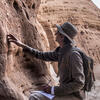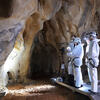You are here
Climate change puts archaeological sites at threat

The Gargas cave, near the village of Aventignan (southwestern France) in the foothills of the Pyrenees, contains a spectacular collection of painted hands, created some 27,000 years ago by our Homo sapiens ancestors. Slightly more than 230 negative hand stencils adorn the rock walls, providing exceptional evidence of Gravettian culture in the Upper Palaeolithic. The problem is that every year, between January and April, a white patch forms on one of the decorated panels, seemingly partially erasing it. "It has been observed for a long time, but fortunately always ends up disappearing, leaving the paintings intact," says Bruno Lartiges1, a specialist in the climatology of underground environments.
However, this phenomenon is a reminder that the preservation of decorated caves relies on a fragile balance that can be affected by many factors, and in particular by climate change. This realisation led to the launch of the DECACLIM2 research project, coordinated by Lartiges. "Based on the study of three sites – Gargas, the Villars cave (Périgord, also in southwestern France) and the Grotte aux Points d'Aiguèze (Gard, southern France) – our goal is to understand the possible impacts of climate change on these ecosystems and identify critical situations or tipping points that could lead to a rapid deterioration of our decorated cave heritage."



This type of research has, for example, helped to explain why the mysterious white patch appears every year at the Gargas cave. Seasonal changes cause areas close to the surface to warm up faster than those at depth. "These temperature differences trigger convection cells – draughts, to put it simply – which dry out the air in the lower part of the gallery," Lartiges explains. This leads to the deposition of minerals, which in turn causes local whitening of the painted wall. In other caves, the opposite problem can arise: an increase in humidity leads to condensation. The paintings become covered by a thin film of water which, if it trickles down, can damage the pigments and corrode the rock.
"The air and walls of the cavities are warming up"
Between 2005 and 2023, the participants in the project placed sensors at various points around the sites in order to take extremely precise measurements of the temperature, humidity, carbon dioxide (CO2) level and thickness of the water films on the walls, as well as of medium- and long-term trends. "We were able to confirm that the air and walls of the cavities have warmed significantly since 2012, even at depth, increasing at Gargas by 0.35 to 0.66 °C over 10 years. The drying out of the karst is also causing CO2 levels to rise." CO2 concentrations in the air can in particular have an impact on the various life forms present in the cave, such as bats and rodents, fungi and bacteria, and, by extension, on the entire ecosystem of the sites.
Such problems don't always occur in the same way. For instance, in the Pech Merle decorated cave (Lot, southwestern France), the tail of a superb horse painted on the rock used to disappear every winter. However, by changing the cave closure system (which modified air flow and CO2 concentrations inside) and improving supervision of tourist visits, the contrast of the painting has been restored to a permanently optimum level.
Satellite monitoring
Around the world, various innovations are helping archaeologists to better cope with global warming. In Spain, the Altamira cave has already experienced worrying increases in CO2 levels due to excessively high numbers of visitors. "Future climate change is likely to boost the growth of microorganisms and lead to the deterioration of rock paintings," warns Sylvain Mangiarotti3, a researcher specialising in chaos theory – more accurately called “nonlinear dynamic systems theory”. The Spanish scientist Marina Sáez contacted him in the mid-2010s with a view to modelling the dynamics of CO2 at the site. "We managed to formulate equations connecting the outdoor temperature, humidity levels on the ground, and CO2 concentrations in the air," Mangiarotti explains.
With the algebraic tools he developed, the French-Spanish team can use satellite measurements of temperature and surface humidity carried out from 2010 to 2023 to reconstruct changes in CO2 levels in the air of the cave: "Once we have the equations and the data, we can go back much further in time." Thanks to this research, they have been able to model CO2 concentrations since the 1950s, particularly during the peak tourist season and at times when the cave was closed.
In the 1970s, the cave attracted up to 170,000 visitors a year and the paintings were visibly deteriorating. The site was closed to the public in 1977 and then partially reopened – for visits in small groups and under strict conditions. "Our work enables us to plan for the future and estimate the maximum sustainable number of visitors," Mangiarotti says. "And it can be applied to any other archaeological site."
Sites doomed to disappear
While global warming may be an exacerbating factor, it is not the only one. "The opening of the Lascaux cave to the public was a traumatic experience," recalls the archaeologist Carole Fritz4, who heads the scientific team at the Chauvet cave. However, attempting to regulate everything would be a mistake, since CO2 has always been present in the caves.
At Chauvet, the fact that the average CO2 level has been rising for 25 years (with warmer winters, plants spend less time in dormancy and release more CO2) presents no danger for the conservation of paintings and engravings. On the other hand, it does bother the research teams, who frequently feel short of breath. In fact, they are no longer allowed to enter the cave when CO2 levels exceed 2.5%, as compared to 0.04% in the open air. "We used to carry out two research campaigns, one in October and the other in the spring," Fritz explains. "But for the past ten years or so we've done away with the October operation."
The archaeologist believes there is no reason to panic in the face of these developments. "These sites have already transitioned from a glacial era to the current epoch, known as the Holocene, so they’ve already experienced periods of warming, although these were more gradual." In other words, we just have to accept that some caves will eventually disappear.
For instance, sea-level rise threatens coastal sites such as that of the Cosquer cave in Marseille (southeastern France), a vast replica of which can now be visited in a specially-dedicated museum at the entrance to the Vieux-Port. The actual cave itself is on the point of disappearing, and what can now be seen is probably only a small part of the original site, which was occupied in prehistoric times. "20,000 years ago, the coastline was five kilometres further south. The topography bore no resemblance to what it is today," Fritz emphasises. Teams of researchers are doing everything they can to gather as much information as possible while the remains are still there. However, rising sea-levels will eventually wash away the rock paintings together with any archaeological deposits.
Coastlines are always vulnerable places. Last spring on the Île d'Yeu (Vendée, western France), erosion threatened a funerary monument uncovered by a storm at the Pointe de Gilberge just a few months earlier: a Bronze Age chest dating back to 1600 BC containing a remarkably well-preserved skeleton. "This is exceptional, because acidic soil usually destroys bones," observes Chloé Martin, an archaeologist at the Éveha consultancy firm in Limoges (central western France). In September, she co-directed emergency excavations with the aim of analysing these remains, which will inevitably be swallowed up by the sea in the near future.
"Global warming and rising sea levels are not the only threats," she points out. "Coastal areas are very densely populated. Human activity there, especially construction, also plays a role." On the Île d'Yeu, housing developments can alter the natural displacement of sand and endanger sites by intensifying natural erosion. This is apparently what happened in the 1950s at Penvénan beach in Brittany, where Bronze Age burial chests were eventually washed away by the sea.

Martin is involved in the participatory research project ALeRT5. Set up in the early 2000s by researchers Marie-Yvane Daire6 and Elias Lopez Romero7, the scheme was developed in response to increasing coastal erosion, and aims to draw up an inventory of endangered coastal sites. "To us, this issue appeared to be insufficiently addressed by heritage conservation policies," Daire says. To get around these difficulties, the ALeRT project enables any walker or amateur archaeologist to report potentially significant discoveries along the coast. For example, after a storm the sand sometimes recedes, revealing hitherto hidden archaeological structures.
"Anyone previously registered on our site can report them to us, enabling us to alert the public authorities on the need to initiate excavations," Daire explains. The programme, which was put on hold for a time due to a lack of funding, was relaunched in 2023 with the backing of the French Ministry of Culture, and should help to mitigate the loss of archaeological heritage and scientific knowledge that threatens to become even greater in years to come. ♦
See also:
Rare Ordovician fossil deposit found in France
- 1. Professor at the Université de Toulouse’s GET geosciences and environment laboratory (CNRS / CNES / IRD / Université Toulouse III – Paul Sabatier).
- 2. https://anr.fr/en/funded-projects-and-impact/funded-projects/project/fun...
- 3. CESBIO centre for space studies of the biosphere (CNRS / CNES / IRD / Université Toulouse III – Paul Sabatier).
- 4. CNRS research professor at the LAMS molecular and structural archaeology laboratory (CNRS / Sorbonne Université).
- 5. https://alert-archeo.org/ (in French)
- 6. CNRS research professor at the CReAAH research centre in archaeology, archaeosciences, and history (CNRS / Le Mans Université / Ministry of Culture / Nantes Université / Université de Rennes / Université Rennes 2).
- 7. Researcher at the Instituto de Arqueología de Mérida (CSIC, Spain), associate member of the CReAAH (CNRS / Le Mans Université / Ministry of Culture / Nantes Université / Université de Rennes / Université Rennes 2).
Explore more
Author
Fabien Trécourt graduated from the Lille School of Journalism. He currently works in France for both specialized and mainstream media, including Sciences humaines, Le Monde des religions, Ça m’intéresse, Histoire or Management.


















